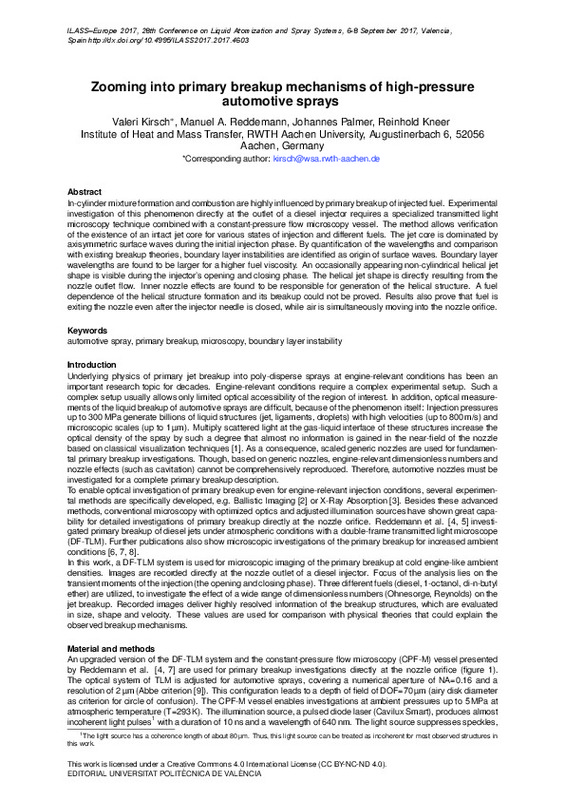JavaScript is disabled for your browser. Some features of this site may not work without it.
Buscar en RiuNet
Listar
Mi cuenta
Estadísticas
Ayuda RiuNet
Admin. UPV
Zooming into primary breakup mechanisms of high-pressure automotive sprays
Mostrar el registro sencillo del ítem
Ficheros en el ítem
| dc.contributor.author | Kirsch, Valeri
|
es_ES |
| dc.contributor.author | Reddemann, Manuel
|
es_ES |
| dc.contributor.author | Palmer, Johannes
|
es_ES |
| dc.contributor.author | Kneer, Reinhold
|
es_ES |
| dc.date.accessioned | 2018-04-11T09:22:24Z | |
| dc.date.available | 2018-04-11T09:22:24Z | |
| dc.date.issued | 2017-07-28 | |
| dc.identifier.isbn | 9788490485804 | |
| dc.identifier.uri | http://hdl.handle.net/10251/100172 | |
| dc.description.abstract | [EN] In-cylinder mixture formation and combustion are highly influenced by primary breakup of injected fuel. Experimentalinvestigation of this phenomenon directly at the outlet of a diesel injector requires a specialized transmitted light microscopy technique combined with a constant-pressure flow microscopy vessel. The method allows verification of the existence of an intact jet core for various states of injection and different fuels. The jet core is dominated by axisymmetric surface waves during the initial injection phase. By quantification of the wavelengths and comparison with existing breakup theories, boundary layer instabilities are identified as origin of surface waves. Boundary layer wavelengths are found to be larger for a higher fuel viscosity. An occasionally appearing non-cylindrical helical jet shape is visible during the injector’s opening and closing phase. The helical jet shape is directly resulting from the nozzle outlet flow. Inner nozzle effects are found to be responsible for generation of the helical structure. A fuel dependence of the helical structure formation and its breakup could not be proved. Results also prove that fuel is exiting the nozzle even after the injector needle is closed, while air is simultaneously moving into the nozzle orifice. | es_ES |
| dc.description.sponsorship | This work was performed as part of the Cluster of Excellence “Tailor-Made Fuels from Biomass”, which was funded by the Excellence Initiative of the German federal and state governments to promote science and research at German universities. | es_ES |
| dc.format.extent | 8 | es_ES |
| dc.language | Inglés | es_ES |
| dc.publisher | Editorial Universitat Politècnica de València | es_ES |
| dc.relation.ispartof | Ilass Europe. 28th european conference on Liquid Atomization and Spray Systems | es_ES |
| dc.rights | Reconocimiento - No comercial - Sin obra derivada (by-nc-nd) | es_ES |
| dc.subject | Automotive spray | es_ES |
| dc.subject | Primary breakup | es_ES |
| dc.subject | Microscopy | es_ES |
| dc.subject | Boundary layer instability | es_ES |
| dc.title | Zooming into primary breakup mechanisms of high-pressure automotive sprays | es_ES |
| dc.type | Capítulo de libro | es_ES |
| dc.type | Comunicación en congreso | es_ES |
| dc.identifier.doi | 10.4995/ILASS2017.2017.4603 | |
| dc.rights.accessRights | Abierto | es_ES |
| dc.description.bibliographicCitation | Kirsch, V.; Reddemann, M.; Palmer, J.; Kneer, R. (2017). Zooming into primary breakup mechanisms of high-pressure automotive sprays. En Ilass Europe. 28th european conference on Liquid Atomization and Spray Systems. Editorial Universitat Politècnica de València. 224-231. https://doi.org/10.4995/ILASS2017.2017.4603 | es_ES |
| dc.description.accrualMethod | OCS | es_ES |
| dc.relation.conferencename | ILASS2017 - 28th European Conference on Liquid Atomization and Spray Systems | es_ES |
| dc.relation.conferencedate | September 06-08,2017 | es_ES |
| dc.relation.conferenceplace | Valencia, Spain | es_ES |
| dc.relation.publisherversion | http://ocs.editorial.upv.es/index.php/ILASS/ILASS2017/paper/view/4603 | es_ES |
| dc.description.upvformatpinicio | 224 | es_ES |
| dc.description.upvformatpfin | 231 | es_ES |
| dc.type.version | info:eu-repo/semantics/publishedVersion | es_ES |
| dc.relation.pasarela | OCS\4603 | es_ES |
| dc.contributor.funder | Wissenschaftsrat, Alemania |








